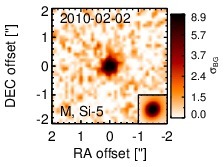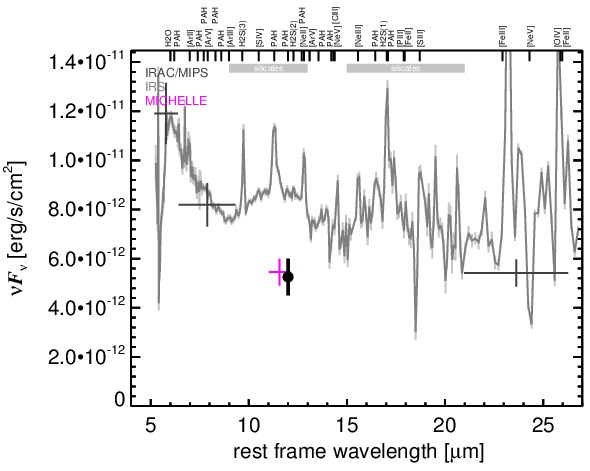Sasmirala Individual Information for NGC 4138
Description
NGC 4138 is an early-type spiral galaxy at a distance of D = 13.8 ± 1.8 Mpc with a Sy 1.9 nucleus [veron-cetty_catalogue_2010] that belongs to the nine-month BAT AGN sample and is an X-ray “buried” AGN candidate [noguchi_new_2009]. A weak compact radio nucleus was detected in NGC 4138 [ho_radio_2001]. This object has not been detected with IRAS but with Spitzer/IRAC, IRS and MIPS. The corresponding images show a compact nucleus embedded within extended host emission and is surrounded by a starburst ring with a major axis diameter of ~ 39arcsec ~ 2.6 kpc along north-west direction. Therefore, our MIPS 24 μm flux of the unresolved nuclear component is significantly lower than the total flux by [temi_spitzer_2009], which includes the whole central region. The IRS LR mapping-mode spectrum suffers from low S/N but indicates PAH emission, possibly weak silicate 10 μm emission, and a shallow blue spectral slope in νFν-space ( see [weaver_mid-infrared_2010] for measurements of forbidden emission lines). We observed the nuclear region of NGC 4138 with Michelle in the Si-5 filter in 2010 and detected a possibly marginally extended MIR nucleus without further host emission (FWHM(major axis) ~ 0.52arcsec ~ 35 pc; PA~ 146∘). However, the current data are not sufficient for a robust classification of the nuclear extension in the MIR at subarcsecond scales. The nuclear photometry is 39% lower than the IRS flux levels, providing additional evidence for significant star formation at least on arcsecond scale in NGC 4138.
- [ho_radio_2001] Luis C. Ho and James S. Ulvestad. Radio continuum survey of an optically selected sample of nearby seyfert galaxies . ApJS , 133 pp. 77–118, March 2001.
- [noguchi_new_2009] Kazuhisa Noguchi, Yuichi Terashima, and Hisamitsu Awaki. A new sample of buried active galactic nuclei selected from the second XMM-Newton serendipitous source catalogue . ApJ , 705 pp. 454–467, November 2009.
- [temi_spitzer_2009] Pasquale Temi, Fabrizio Brighenti, and William G. Mathews. Spitzer observations of passive and star-forming early-type galaxies: An infrared color-color sequence . ApJ , 707 pp. 890–902, December 2009.
- [veron-cetty_catalogue_2010] M.-P. Véron-Cetty and P. Véron. A catalogue of quasars and active nuclei: 13th edition . A&A , 518 pp. 10, July 2010.
- [weaver_mid-infrared_2010] K. A. Weaver, M. Meléndez, R. F. Mushotzky, S. Kraemer, K. Engle, E. Malumuth, J. Tueller, C. Markwardt, C. T. Berghea, R. P. Dudik, L. M. Winter, and L. Armus. Mid-infrared properties of the swift burst alert telescope active galactic nuclei sample of the local universe. i. emission-line diagnostics . ApJ , 716 pp. 1151–1165, June 2010.
Images

Optical image (DSS, red filter). Displayed are the central 4 arcmin with North being up and East to the left. The colour scaling is linear with white corresponding to the median background (BG) and black to the 0.01% pixels with the highest intensity.

Spitzer MIR images. Displayed are the inner 40 arcsec with North being up and East to the left. The colour scaling is logarithmic with white corresponding to median BG and black to the 0.1% pixels with the highest intensity. The label in the bottom left states instrument and central wavelength of the filter in micron (I: IRAC, M: MIPS).

Subarcsecond-resolution MIR images sorted by increasing filter central wavelength. Displayed are the inner 4 arcsec with North being up and East to the left. The colour scaling is logarithmic with white corresponding to median BG and black to the 75% of the highest intensity of all images in units of sig_bg. The inset image (where present; either bottom or top right) shows the central arcsecond of the PSF from the calibrator star, scaled to match the science target. The labels in the bottom left state instrument and filter names (C: COMICS, M: Michelle, T: T-ReCS, V: VISIR).
SEDs


MIR SED. The description of the symbols in all the SED plots (where present) is the following: Grey crosses and solid lines mark the Spitzer/IRAC, MIPS and IRS data. The colour coding of the other symbols is as follows: green for COMICS, magenta for Michelle, blue for T-ReCS and red for VISIR data. Darker-coloured solid lines mark spectra of the corresponding instrument. The black filled circles mark the nuclear 12 and 18 micron continuum emission estimate from the data (where present). The ticks on the top axis mark positions of common MIR emission lines, while the light grey horizontal bars mark wavelength ranges affected by the silicate 10 and 18 micron features.